

Termite. Like ants, and some bees and wasps—which are all placed in the separate order Hymenoptera—termites divide labor among castes, produce overlapping generations and take care of young collectively.
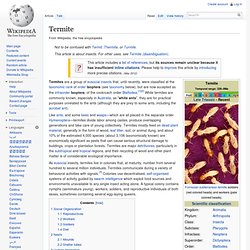
Termites mostly feed on dead plant material, generally in the form of wood, leaf litter, soil, or animal dung, and about 10% of the estimated 4,000 species (about 3,106 taxonomically known) are economically significant as pests that can cause serious structural damage to buildings, crops or plantation forests. Termites are major detritivores, particularly in the subtropical and tropical regions, and their recycling of wood and other plant matter is of considerable ecological importance. As eusocial insects, termites live in colonies that, at maturity, number from several hundred to several million individuals. Social Organization[edit] Reproductives[edit] At maturity, a primary queen has a great capacity to lay eggs. Workers[edit] Worker termite Soldiers[edit] Diet[edit] Termite Fecal Pellets. Trichonympha. Trichonympha is a genus of parabasalian protists that live in the intestines of many, if not most, termite species.
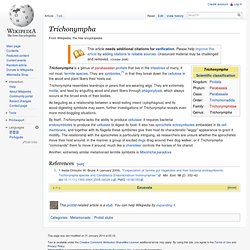
They are symbiotes,[1] in that they break down the cellulose in the wood and plant fibers their hosts eat. Trichonympha resembles teardrops or pears that are wearing wigs. They are extremely motile, and feed by engulfing wood and plant fibers through phagocytosis, which always occurs at the broad ends of their bodies. As beguiling as a relationship between a wood-eating insect (xylophagous) and its wood-digesting symbiote may seem, further investigations of Trichonympha reveals even more mind-boggling situations. By itself, Trichonympha lacks the ability to produce cellulase; it requires bacterial endosymbiotes to produce the cellulase to digest its food.
Endosymbiont. An endosymbiont is any organism that lives within the body or cells of another organism, i.e. forming an endosymbiosis (Greek: ἔνδον endon "within", σύν syn "together" and βίωσις biosis "living"). Examples are nitrogen-fixing bacteria (called rhizobia), which live in root nodules on legume roots, single-cell algae inside reef-building corals, and bacterial endosymbionts that provide essential nutrients to about 10–15% of insects.
Many instances of endosymbiosis are obligate; that is, either the endosymbiont or the host cannot survive without the other, such as the gutless marine worms of the genus Riftia, which get nutrition from their endosymbiotic bacteria. The most common examples of obligate endosymbioses are mitochondria and chloroplasts. Some human parasites, e.g. Wuchereria bancrofti and Mansonella perstans, thrive in their intermediate insect hosts because of an obligate endosymbiosis with Wolbachia spp. Five Major Misconceptions about Evolution. Five Major Misconceptions about Evolution Copyright © 1995-1997 by Mark Isaak[Last Update: October 1, 2003] large part of the reason why Creationist arguments against evolution can sound so persuasive is because they don't address evolution, but rather argue against a set of misunderstandings that people are right to consider ludicrous.
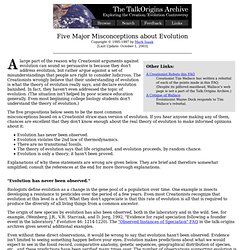
Evolution and Chance. Evolution and Chance Version 2.1 Draft 1 Copyright © 1996-1997 by John Wilkins[Last Update: April 17, 1997] ne of the recurring attacks on evolution comes from those who find the notion of random change distasteful.

One of the more pernicious and persistent claims is Fred Hoyle's oft-quoted comment that accepting that evolution occurs by selection is like thinking that a 747 would result if a hurricane went through a junkyard [Hoyle 1981]. Some writers on evolutionary theory have not helped this misconception, although those who repeat it are remarkably resistant to correction on the actual claims made by scientific evolutionary theory. Others have dealt elsewhere with the exaggerated claims about Lamarckian inheritance, Hopeful Monsters, macromutation and dogs giving birth to cats. Control theory. The concept of the feedback loop to control the dynamic behavior of the system: this is negative feedback, because the sensed value is subtracted from the desired value to create the error signal, which is amplified by the controller.
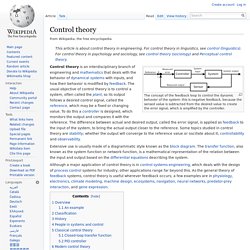
Extensive use is usually made of a diagrammatic style known as the block diagram. The transfer function, also known as the system function or network function, is a mathematical representation of the relation between the input and output based on the differential equations describing the system. Although a major application of control theory is in control systems engineering, which deals with the design of process control systems for industry, other applications range far beyond this.
A Brief History of Complexity Theory. A Brief History of Complexity Theory A new scientific discipline, called complexity theory , looks at complex systems and their environments in much the same way as chaos theory.
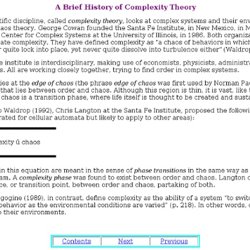
George Cowan founded the Santa Fe Institute, in New Mexico, in May, 1984. Stephen Wolfram began the Center for Complex Systems at the University of Illinois, in 1986. Both organizations were founded to investigate complexity. Norman Packard. Norman Packard Norman Harry Packard (born 1954 in Billings, Montana)[1] is a chaos theory physicist and one of the founders of the Prediction Company and ProtoLife.
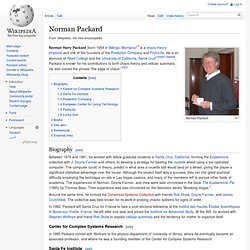
He is an alumnus of Reed College and the University of California, Santa Cruz[citation needed]. Packard is known for his contributions to both chaos theory and cellular automata. Random number generation. A random number generator (RNG) is a computational or physical device designed to generate a sequence of numbers or symbols that lack any pattern, i.e. appear random.

The many applications of randomness have led to the development of several different methods for generating random data. Middle-square method.